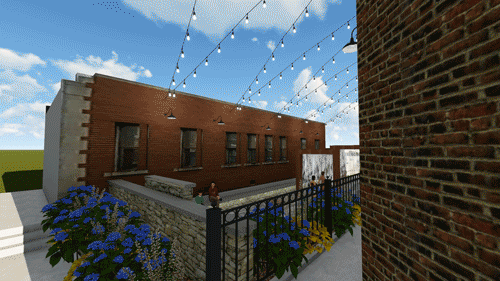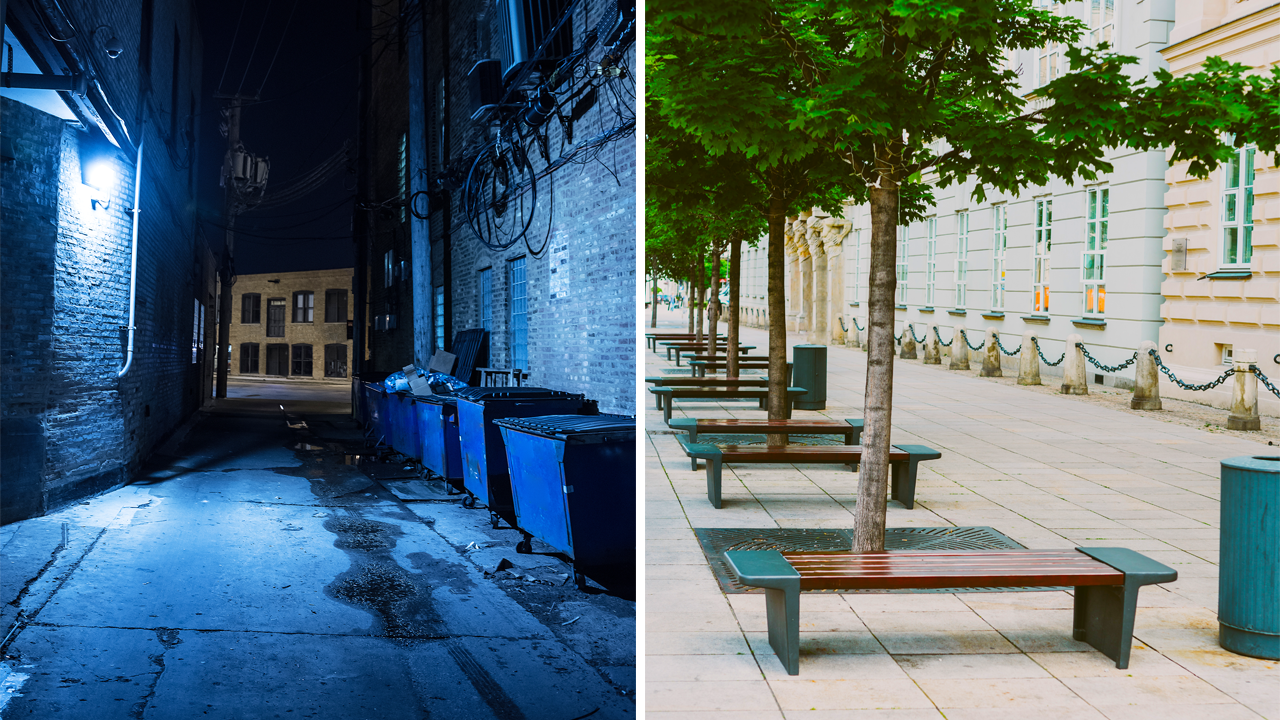Today, renters and buyers demand flexibility. Some want to live downtown. Others seek that downtown, connected feel but from the suburbs or outskirts.
As a result, communities of 1,000 to 1 million are seeking creative ways to accommodate the needs of all users and attract more residents.
Alleyways and specifically green alleys have become a proven and creative solution.
Communities are kick-starting economic growth and development, connectivity for pedestrians, green and sustainable infrastructure, safety and cultural/community pride by investing in green alleys and alleyway development programs. Below we explore traditional alleyways compared to the present, what sparked change in recent years and five steps you can take to get started.
Traditional Alleyways: Cramped, Dirty, Forgotten
What comes to mind when a peer mentions alleys? Throughout the U.S., alleys are often viewed as cramped spaces that house dumpsters, litter and darkness. In terms of use, we all recognize that they play host to services for businesses like trash removal, emergency exits, utility access and deliveries. Even still, they’re often viewed as unsafe and dirty by the general public.

Abroad, the perception is quite different. In attractive cities built for walking and exploration like Paris, Rome and Barcelona, alleys serve as beautiful and vital pedestrian passageways. In Kyoto, Japan and Melbourne, Australia (the beautiful Centre Place, for example) they’re retail hubs – clean, bright and full of cultural expression.
Creating this type of atmosphere in the U.S. – the Midwest in particular – has been a challenge, as we drive a significant amount more than other countries. We also have harsh winters and unpredictable seasons. That said, as the focus on environmental sustainability grows and cities of all sizes seek to become more destination than pit stop, this challenge has turned into a trend that’s caught on.

The Business, Safety and Environmental Case For Change
Many communities are seeking to increase their density to bring greater revenue, people and popularity to the area. The opportunity in alleys? To start, alleyways often run between retail shops, art galleries, eateries and breweries, among countless other local businesses, and they often connect to a city or town’s main street and other social gathering places.
Benefits of Alleyway Redevelopment:
- Creates high value retail space
- Creates additional space for local businesses
- Public safety
- Inviting to private developer investment
- Funding opportunities
- Community gathering focal points
- Destinations for visitors and natives alike
- Opportunity to celebrate cultural diversity
- Improved stormwater management
- Environmental sustainability
Alleys that are repurposed as inviting and engaging pedestrian corridors provide convenient, direct connectivity between offsite parking ramps/lots and downtown areas – rather than taking the long-way around as we are likely to do when seeing a dank, trash-filled alley amidst a beautiful downtown area. As the backdrop of local businesses, they can also function as high value, inexpensive retail space.
Alleyway development can improve public safety, create patio dining areas during warmer months and is inviting to private developers, potentially delivering millions in investment and revenue to an untapped area. It can also decrease maintenance costs while enabling beautification and expansion should the owner(s) give way to private developers or a group of businesses.
As communal gathering spaces, alleys can play host to community events like movie nights, farmer’s markets and small concerts. They also provide opportunity for communities to showcase the area’s history, culture and community pride through murals and other historical artifacts.
Beyond economic development and cultural/community pride, alleys greatly impact our ecosystems as they often run along storm sewer lines – creating the opportunity to simultaneously better the environment. In light of this, we’ve witnessed a bit of a “green alley” boom in the 21st century.
The Rise of Green Alleys
Chicago is widely viewed as the “alley capital” of the country, featuring more than 1,900 miles of alleys throughout the City. How much space does this amount to? Nearly five mid-sized airports (3,500+ acres). Recognizing the dire need to make meaningful use of all this space, in 2006 Chicago carefully evaluated its 13,000+ alleys. Local leaders found a significant problem.
Decades ago, most of Chicago’s alleys were paved with impermeable asphalt or concrete – meaning stormwater drained through grates at the center. Over the years these systems fell into disrepair through lack of maintenance, and flooding became commonplace. Without proper stormwater management, rainwater floods would flush out dirt and grime into the streets, rivers and eventually the surrounding lakes.
In response, the City kicked off its Chicago Green Alley Program, one of the first in the U.S. to bring “sustainable building practices” to a large network of alleyways. Since the program first began, more than 300 Green Alleys have been installed. These alleys have been covered with permeable surfaces that now redirect stormwater into the ground and away from Chicago’s “overtaxed” sewer system – reducing flooding and reinvigorating the surrounding soil.
Green alleys are designed to capture and filter up to 15,000 gallons of rain water every storm – sending only clean water through pipes and into our rivers and lakes.
Other cities like Los Angeles, Detroit and Milwaukee have taken a similar approach. Specific to the West Coast, Los Angeles has begun creating a network of green alleyways that is expected to help the City meet its goal of increasing stormwater capture to 50 billion gallons by 2035; currently, the city saves 8.8 billion gallons annually according to The New York Times.
In the Midwest, in addition to the 300 that have been installed in Chicago, Iowa now has 80+ green alleys, more than 10 green alleys are occupying the streets of the Greater Milwaukee Area, and in Detroit a community-driven program has been in place since 2010.
Challenges, Next Steps
As communities consider whether alley redevelopment – for economic development and/or environmental sustainability purposes – is a worthwhile effort, factors such as unclear ownership (e.g., alleys may be owned and maintained by the municipality, state transportation agencies or privately owned by neighboring property), low visibility and making sure the services alleys allow for can continue are important challenges that must be understood and confronted.
There are steps communities can take to both better understand the “why” behind alleyway transformation, as well as where to begin:

1. Gain an Understanding of Your Alleyways
Seek to gain a full understanding of your alleyways – including and especially who owns the alleys (i.e., the municipality, state transportation agency or privately owned by neighboring property owners) – if it’s public space, private or shared. Explore the results achieved by nearby communities, both successful and challenging. Lastly, uncover the unique attributes your alleyways bring to the community, such as connectivity, current usage, condition and potential.

2. Engage and Learn From the Community
Get the public involved! Community residents are often highly encouraged by investments in the area; connect with them for ideas, to understand how they might use these areas, and to uncover the type of buy-in there might be.

3. Consider a Test Run
Test the theories you develop by temporarily using an in-good-shape alley or location nearby as a gathering point for a communal event. Showcase a family movie or sporting event using a projection system, set up a farmer’s market or seek out local musicians willing to put on a show. Evaluate the public reaction throughout to build your case.

4. Invest in Your Ideas
Explore funding opportunities, ways the public can get involved and create a focus on these areas; your community will likely engage, and their buy-in just might help in the monetary aspects of alleyway projects. There are often a number of funding and grant opportunities for projects that are green, community-focused and reciprocal to the local economy.

5. Plan for Your Success
Above all, create a plan or include in your master program. If alleyway activation is something your community is considering, create a plan and take action – even if it’s just evaluating the potential opportunities.
Alleys shouldn’t just serve as service lanes. Throughout the U.S., they’re steadily becoming important social gathering spaces, citywide connectors and friendly recreational areas. Don’t let your alleys become a blighted area that is avoided, forgotten and wasted. Start the conversation, and perhaps ignite economic development and environmental change.
About the Author

Brea Grace, AICP, is a certified urban and land use planner with 20+ years working in the public and private sectors. Brea is a creative thinker and passionate about building better communities through urban redevelopment, waterfront redevelopment and creating unique urban places. In addition, she is highly experienced in public outreach and project financing, including grant writing and economic development.

.png?width=113&name=SEH_Logo_RGB%20(1).png)
